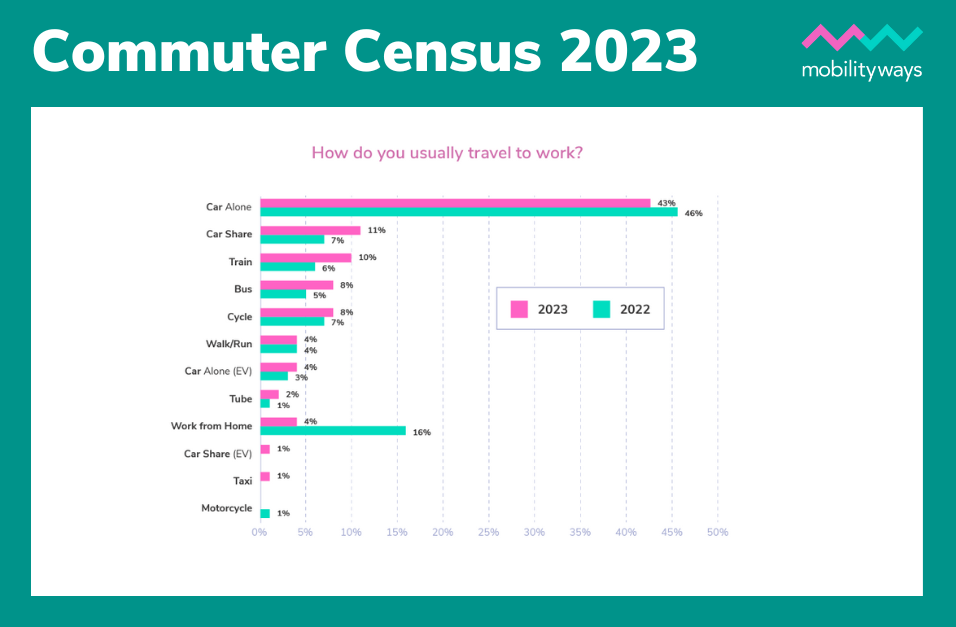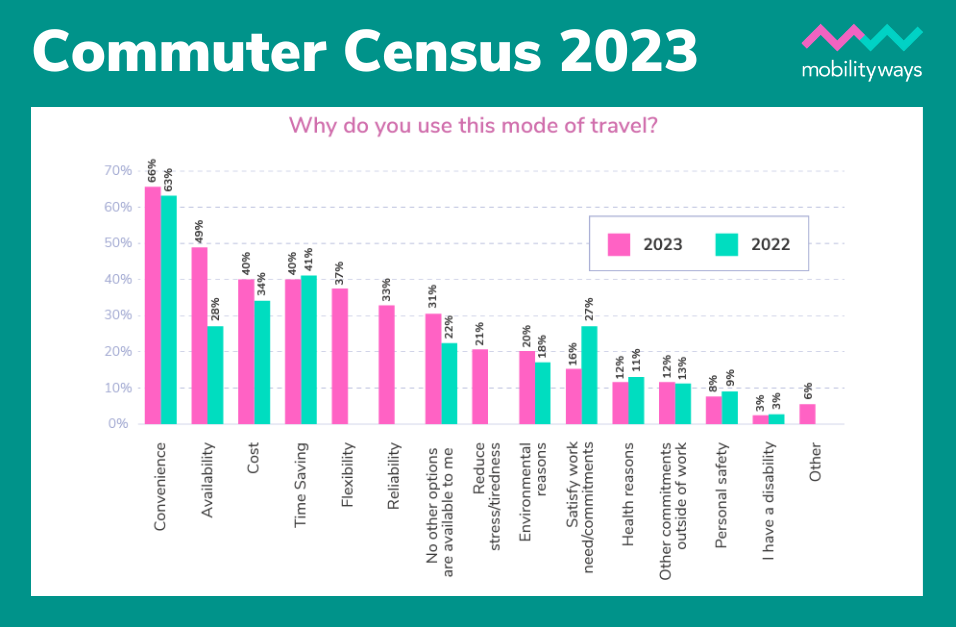INSIGHT ARTICLE
2023 Commuter Census: An executive summary
By Jack Goddard, Senior Marketing Executive
Analysing the responses of 7,439 individual commuters has shown that, as more people travel to work again, they’re choosing more sustainable modes. While driving alone is still easily the most common mode of travel, the vast majority of respondents are ready and willing to change their behaviour and leave the car behind.
Sustainable transport is on the rise
The data we have gathered in this year’s Commuter Census shows that there has been a shift towards more days back in the workplace, with fewer people working from home. Just 4% of respondents now say they usually work from home, down from 16% in 2022, leading to a fascinating change in habits and opinions as people return to working on site more of the time.
Car usage levels remain high – if you include EVs, there’s only a 2% year-on-year drop in driving to work alone. More promising, however, is
the rise in usage for all modes of sustainable transport. The largest rise in car-sharing, which has gone up by 5% since 2022. Plus, just 16% of respondents said they could not be encouraged to car share at all.
Commuters may be beginning to put the environment first but they need the right resources at their disposal, as indicated by the increase in respondents who named availability as the biggest factor for their current choice of transport.
The UK Government announced its “Commute Zero” policy as part of the Transport Decarbonisation Plan in July 2021, but as yet this hasn’t had a large impact on sustainable trips to work. The Commuter Census 2023 shows that the willingness from commuters is there: Now they need the support – in the form of work-from-home and car-sharing policies, and better public transport infrastructure.

Is the car still as common?
By far the most common mode of travel is commuting by single-occupancy vehicle (SOV), but the dial is now beginning to shift.
The SOV still dominates the mobility landscape, but 43% of respondents now drive to work in a diesel or petrol car alone, compared to 46% in 2022. The number of single-occupancy EV commuters has very gradually increased, from 3% to 4%, which is in line with the general rise in usage of EVs nationwide.
Solo drivers of cars, vans and EVs combined made up 47% of all commuters in 2023. This is actually an increase from the single-occupancy commute levels recorded in the Government’s 2021 Census, which saw 45.1% of commuters driving to work in a car or van. It’s clear that the car remains a primary method of transport, but there are signs
of car usage changing, as car-share numbers have risen from 7% of commuters in 2022 to 12% this year (including car share EV).
The most significant change was in usually working from home – which dropped substantially, from 16% to just 4% of respondents. This naturally indicates that more people are commuting more days a week than in 2022, as mirrored in our analysis on flexible commuter that follows.
It appears that people may be returning to the office more sustainably, however, as almost all modes of transport other than SOV rose year on year. As well as car-sharing, cycling and train, bus, tube, metro and tram use have all increased in the last 12 months.
The bus services are unreliable and often don’t turn up or are so late that I am late for work or have to get a taxi. Reliable bus services would help remove the use of car/taxi on the road. I also prefer to walk or cycle when the weather is good, however it doesn’t feel safe to do so during busy hours – I’m uncomfortable weaving with buses.Victoria from Cambridge, survey respondent
You might also enjoy:
Cost of living and commuter trends
Analysis of half a million postcodes shows latent potential of the sustainable commute

The desire is there, but is the infrastructure?
Encouragingly, this year’s Commuter Census reveals more considerable appetite for change than the same survey showed just 12 months ago.
There is still plenty of work to be done: The number of people using more sustainable methods to commute to work has slightly increased but, as discussed elsewhere in this Census, a higher percentage of people are using SOVs to get to work than two years ago – so the shift to sustainable transport needs to be more significant.
Despite “convenience” again being listed as the biggest reason for people’s current commute, one of the most notable findings was that lack of “availability” as a barrier to change rose by 21% year on year – meaning the appetite to find different modes of transport is growing.
There is therefore a requirement for more sustainable commuting schemes, more cycling and walking lanes, and a more reliable public transport network, to help turn this year’s small increase in sustainable commuting into a more substantial one.
There has been more investment in walking and cycling, with a £200 million fund made available in February 2023 to upgrade routes and paths across the country. However, as our Census found, the average commute for cyclists and walkers was five miles and one miles respectively. This means the benefit of this investment might not be felt by many as, according to the 2021 National Census, 64.6% of commuters live at least 10 kilometres (6.2 miles) away from the office.
For now, it’s every employer’s obligation to facilitate sustainable commuting. Organisations who support and incentivise their teams to do so generate benefits for everyone involved; from financial cost and environmental savings, to increases in productivity and engagement. This is why forward-thinking employers are now proactively seeking to reduce commuting emissions and are making progress towards their net-zero goals.
The Government needs to invest and support heavily in infrastructure i.e. coach and rail to support and encourage people to leave their cars and actively seek alternate forms of transport. Penalising people with low emission zone fines, without alternative solutions, is frustratingly short-sightedMark from Nuneaton, survey respondent
Read the full 28-page Commuter Census 2023 now using the button below.
Start your Zero Carbon Commuting journey with a free consultation with one of our Commutologists
Get in touch now
Tell us a little more about your company, and we’ll call you back.